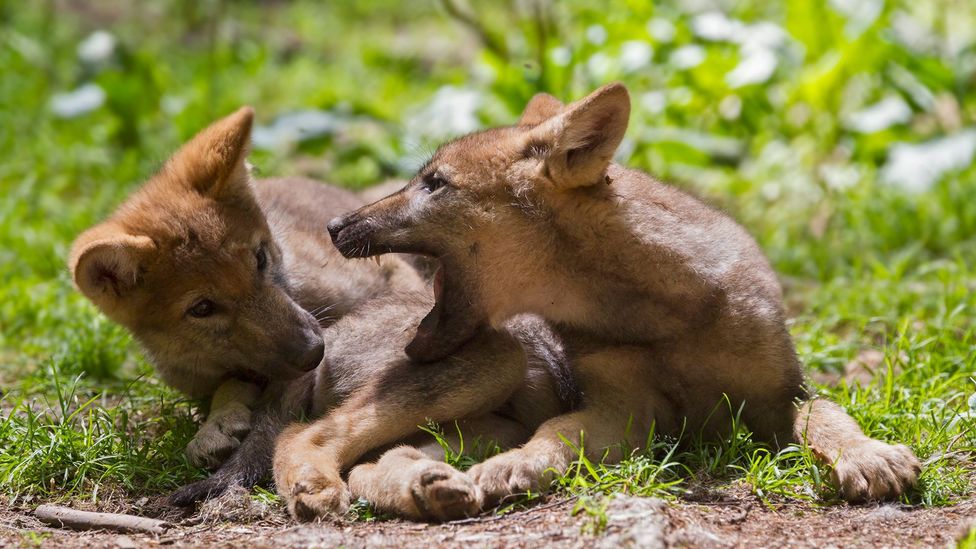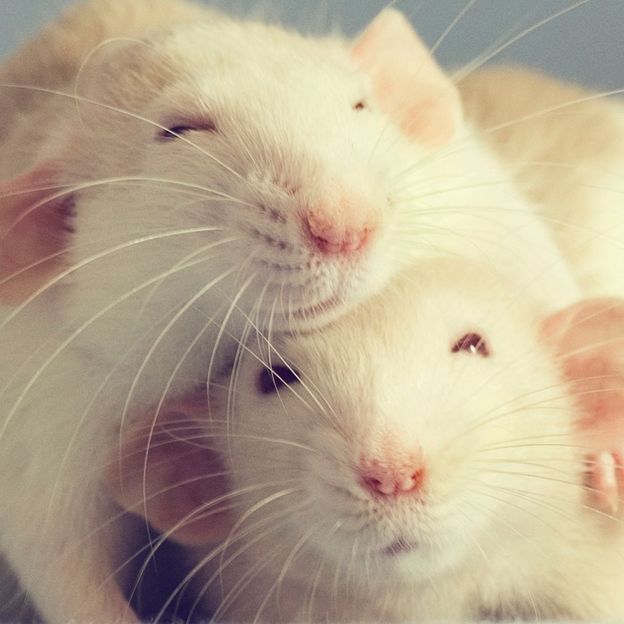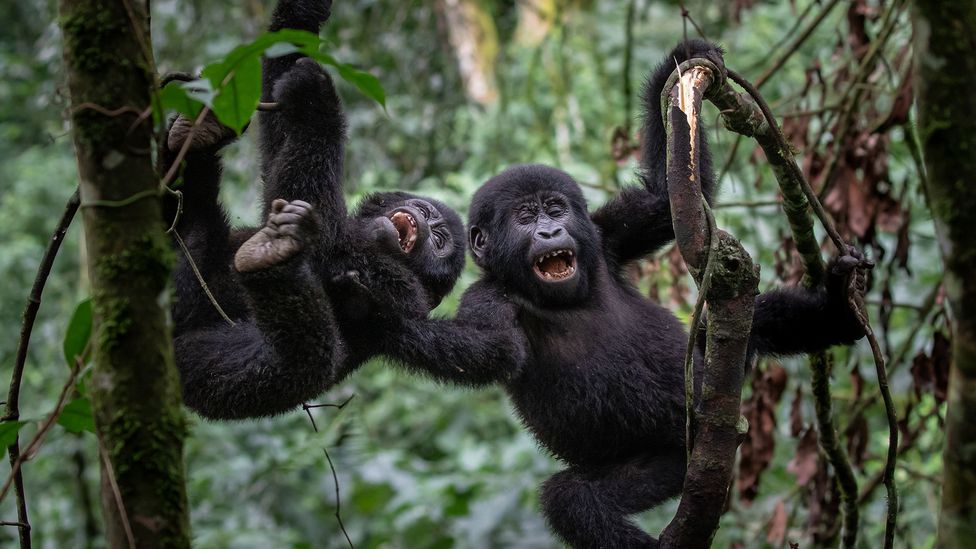When you think about what sets our species apart from other animals, a good sense of humour probably features fairly high up on the list.
We love to laugh – so much so, that an appreciation of comedy seems almost ingrained into our species. Babies as young as three months old giggle and find it hilarious when their parents pull funny faces. By eight months, infants have learned how to use their own faces, bodies and voices to make grown-ups laugh. Soon after, parents may notice that their child has turned into a full-time comedian, deliberately playing with things they know they shouldn't with a cheeky grin on their face.
However, a new study shows that humans may not be alone in their love of playing practical jokes. Animals can tease each other too. Together with colleagues, Isabelle Laumer, a post-doctoral researcher at the University of California Los Angeles (UCLA), watched over 75 hours of videos of great apes interacting with each other. Great apes are our closest living relatives, and include orangutans, chimpanzees, bonobos and gorillas. The apes in the study all lived in zoos, and were filmed attending to their daily routines.
Members of all four species were observed teasing one another. The researchers identified 18 distinct teasing behaviours, with the top five including poking, hitting, hindering the movement of a fellow ape, body slamming, and pulling on a body part. Some apes repeatedly waved body parts or objects in front of their fellow apes' faces, or, in the case of orangutans, pulled each other's hair.

Dogs can be encouraged to play by approaching with a loping gait and then suddenly running away (Credit: Getty Images)
"What we saw often was that a juvenile would sneak up behind an adult that was busy grooming another ape, and proceed to poke them or hit them on the back, sometimes even surprising them," says Laumer, first author of the study.
"They'd then wait and watch for the adult's response. Usually, the target would just ignore them, and so they'd persist in their teasing, making the behaviour more and more elaborate and difficult to ignore, until they sometimes ended up slamming the adult with their entire body."
The teasing behaviour was similar to that adopted by young human children, according to the researchers, in that it was intentional, provocative, persistent and included elements of surprise, play and checking for the recipient’s response. The human equivalent might be sticking your tongue out at someone and then running away to gauge their reaction.
Many scientists believe that humour is far more widespread amongst the animal kingdom
This style of teasing could even form the foundation for more complicated forms of humour. "Joking in humans requires quite complex cognitive abilities," says Laumer. "You need theory of mind (the ability to imagine the world from someone else's perspective), knowledge of social norms, the ability to anticipate others' responses and to appreciate the violation of other's expectations," she says.
As all four great ape species are capable of playful teasing, it suggests that a sense of humour may have been present in our last common ancestor, who lived 13 million years ago.
However, many scientists believe that humour is far more widespread amongst the animal kingdom than this. For example, in his book The Descent of Man, biologist Charles Darwin suggests that dogs may have a sense of humour, writing:
"If a bit of stick or other such object be thrown to one, he will often carry it away for a short distance; and then squatting down with it on the ground close before him, will wait until his master comes quite close to take it away. The dog will then seize it and rush away in triumph, repeating the same manoeuvre, and evidently enjoying the practical joke."

Wolves and other species related dogs also seem to share some of the traits related to play (Credit: Getty Images)
Anyone who owns a dog may have also noticed that during play, they produce a sort of breathy snorting sound that almost sounds like laughter. In a 2005 study, animal behaviourist Patricia Simonet played the sound to dogs at a rescue shelter. She found that listening to dog "laughter" made the shelter dogs less stressed out.
Marc Bekoff, professor emeritus of ecology and evolutionary biology at the University of Colorado, Boulder, says he has collected decades worth of data showing dogs engage in teasing behaviour similar to that shown by Laumer and her colleagues.
For example, when trying to get an otherwise reluctant dog to play, one dog may approach another with a loose gambolling gait before running away.
"I've seen this in dogs, foxes, wild coyotes and wild wolves," says Bekoff.
In fact, Bekoff says that during his career he has heard stories about many species who act like stand-up comedians and jokesters, including horses, Asian black bears and the scarlet macaw.
There's even evidence that rats enjoy a good laugh
Meanwhile, other researchers have noted that dolphins appear to produce sounds of joy while they are play-fighting, and elephants trumpet in excitement when playing. Some parrots have been known to tease other animals for fun, for example by whistling at and confusing the family dog.
There's even evidence that rats enjoy a good laugh. For the last decade or so, Jeffrey Burgdorf, research associate professor at Northwestern University in the US, has been tickling rats for a living. When the rats are tickled, they squeak joyfully in a high-pitched noise similar to a giggle. They come back again and again for more, and can even be taught to play hide and seek for a "tickling reward", according to work done by a separate group at the Humboldt University of Berlin. Now Burgdorf and his team are using their findings to inform treatments for depression.
"What we've been learning is that the animals are most attentive when they are making these vocalisations," says Burgdorf.

Rats have been observed emitting a high-pitch "giggle" when tickled (Credit: Getty Images)
"My supervisor [neuroscientist Jaak Panksepp] would always say play is the fertiliser for the brain, and it's true. Their brains are connecting. They're making new synapses and new neural connections. And so I think that tells us that when we're in those playful humorous moods, we're actually performing at our best and we are being our best selves," says Burgdorf.
However, while rats clearly love being tickled, is their high-pitched giggle really evidence that they have a sense of humour? Most of the evidence for animals having a sense of humour is predominantly anecdotal, as few large-scale studies have been conducted. It's also difficult to know why an animal engages in a certain behaviour. Are the apes in Laumer's study simply playing a practical joke, or are they trying to defuse tension, initiate play, or even just get attention?
What better way to make friends, after all, than to share a good joke?
"Do I think that animals have a sense of humour? Yes, I think they do, but it's difficult to prove," admits Bekoff.
"For example, I've come across households with two dogs, where at feeding time one dog runs to the front door and barks. The other dog then runs to see who's there, while the first dog runs back and eats their food. So, you could say that's showing a sense of humour, but the first dog may have just learned that that's how they get more food," says Bekoff.
You might also like:
- The giant tortoises rebuilding a Galapagos island
- The wildly successful romances found in wildlife
- The UK is bracing for a cicada megaswarm
There's also the question of what evolutionary purpose humour could serve in animals. In humans, it's thought that laughter evolved as a way of help individuals bond. What better way to make friends, after all, than to share a good joke?
Is it possible that humour serves the same role in animals?
"In humans, humour can serve as like an ice-breaker, removing social barriers and strengthening relationships," says Laumer. "We don't know if it's the same in apes or other animals, but it's possible. To know for sure we would need to test and observe more groups of primates and other species," she says.
--
If you liked this story, sign up for The Essential List newsletter – a handpicked selection of features, videos and can't-miss news delivered to your inbox every Friday.
Join one million Future fans by liking us on Facebook, or follow us on Twitter or Instagram.
